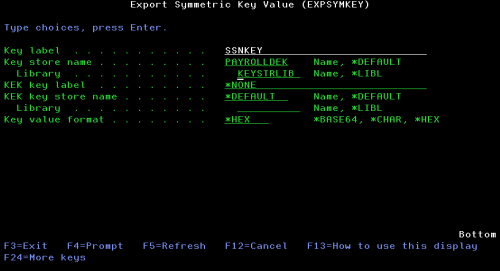Export Symmetric Key (EXPSYMKEY)
The EXPSYMKEY command allows authorized users to extract the value of a Symmetric Key (DEK) contained within a Key Store. This command is useful if the key value needs to be shared with another computer system (which is not an IBM i) which needs to encrypt or decrypt data using the same key.

It is recommended to specify a KEK (Key Encryption Key) to protect the exported Symmetric Key.
The Key Policy must allow key values to be retrieved with the parameter setting of DEKRTVVAL(*YES) or (*KEK).
The following users can utilize the EXPSYMKEY command:
- QSECOFR user profile (unless excluded in the Key Officer settings)
- A user profile with *SECADM authority (unless excluded in the Key Officer settings)
- A Key Officer that has a *YES specified for the “Maintain DEKs” authority setting
How to Get There
From the Symmetric Encryption Key Menu, choose option 15.
Options
Key label (KEYLABEL)
Indicate the label of the Symmetric Key to export.
Key store name (KEYSTR)
Indicate the object name and library of the Key Store which contains the Symmetric Key.
The possible library values are:
KEK key label (KKEYLABEL)
Indicate the label of the Key Encryption Key (KEK) to use to encrypt the Symmetric key that will be exported.
The possible values are:
KEK key store name (KKEYSTR)
Indicate the object name and library of the Key Store which contains the Key Encryption Key (KEK).
The possible library values are:
Key value format (KEYVALFMT)
Indicate if the key should be exported in hexidecimal, base64 or character format.
Generally the key should always be exported in hexadecimal or base64 format to ensure compatibility with other computer systems.
The possible values are:
|
Type choices, press Enter.
Key store name . . . . . . . . . PAYROLLDEK Name, *DEFAULT Library . . . . . . . . . . . KEYSTRLIB Name, *LIBL KEK key label . . . . . . . . . *NONE KEK key store name . . . . . . . *DEFAULT Name, *DEFAULT Library . . . . . . . . . . . _____________ Name, *LIBL Key value format . . . . . . . . *HEX *BASE64, *CHAR, *HEX Key value . . . . . . . . . . . C2D6C240D3E4C5C2C2C540C1E340D3C9D5D6D4C1 40E2D6C6E3E6C1D9C5404040 |
Screen Example: EXPSYMKEY Command with Sample Values